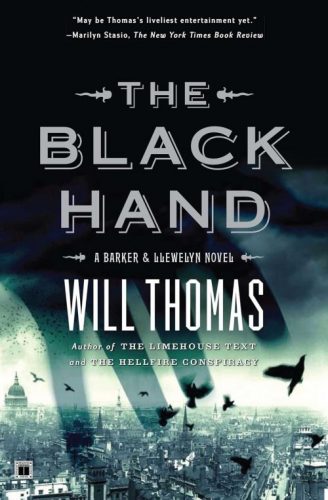 The Black Hand (Barker & Llewelyn, #5) by Will Thomas
The Black Hand (Barker & Llewelyn, #5) by Will Thomas Format: ebook
Source: purchased from Amazon
Formats available: paperback, ebook, audiobook
Genres: historical fiction, historical mystery, mystery
Series: Barker & Llewelyn #5
Pages: 289
Published by Touchstone on July 1, 2008
Purchasing Info: Author's Website, Publisher's Website, Amazon, Barnes & Noble, Kobo, Bookshop.org, Better World Books
Goodreads
When an Italian assassin's body is found floating in a barrel in Victorian London's East End, enquiry agent Cyrus Barker and his assistant Thomas Llewelyn are called in to investigate. Soon corpses begin to appear all over London, each accompanied by a Mafia Black Hand note. As Barker and Llewelyn dig deeper, they become entangled in the vendettas of rival Italian syndicates -- and it is no longer clear who is a friend or foe.
My Review:
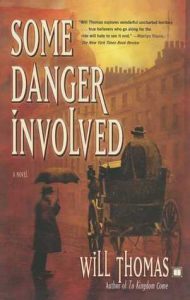 So far, at least, the Barker & Llewelyn series is a bit like a caper movie. Not that Cyrus Barker and his assistant Thomas Llewelyn are committing capers – their job is to either thwart or investigate such goings-on. Instead, just like a good caper movie, the story opens at a climactic moment and then rewinds to the beginning of the story we’ve just been dropped into the middle of so we can see how things came to such a desperate pass.
So far, at least, the Barker & Llewelyn series is a bit like a caper movie. Not that Cyrus Barker and his assistant Thomas Llewelyn are committing capers – their job is to either thwart or investigate such goings-on. Instead, just like a good caper movie, the story opens at a climactic moment and then rewinds to the beginning of the story we’ve just been dropped into the middle of so we can see how things came to such a desperate pass.
As those climactic moments are generally life-threatening, and specifically threatening to the life of Thomas Llewelyn, it’s a good thing that we go into that pulse-pounding scene knowing that Llewelyn must have survived. After all, part of his job as private enquiry agent Cyrus Barker’s assistant is to chronicle Barker’s cases – and dead men tell no tales.
The tale that Llewelyn has to tell this time around is the story of a brewing turf war among London’s criminal underbelly. There’s a new player in the old game of gangs and turf and money, but a new player under a very old and familiar name – the Sicilian Mafia.
Muscling for territory in wide-open London with their signature stilettos against native gangs and older immigrant groups who rely on fists, brickbats and other coshes to get their dirty work done, the incomers cut a wide swath, literally, through the forces scrambling to array against them.
Including both Scotland Yard and the Home Office, which is where Barker and Llewelyn get dragooned into the fight. A fight that Barker most certainly did not start, but is utterly determined to finish – no matter how many favors he has to call in, how many compromises he has to make, or how many of his own hostages to fortune he has to put in harm’s way.
Escape Rating A+: There are three – well, at least three – things going on in this book, and every single one of them just adds to the reader’s compulsion to keep turning the pages, starting from that chilling, riveting opening.
The first thing, of course, is the case itself. The Mafia – or at least one arm or finger of that organization – is doing its damndest to carve out a toehold for itself in London – by carving up as many as possible until they get their way.
Barker’s remit – to be handled however he sees fit – is to make London so hot for the Sicilian gangs that they go back to Sicily, before their brand of bloody assassination becomes the norm in London.
But just because Barker has carte blanche from the Home Office, that doesn’t mean they’ll provide him with anything else, and certainly not any of their own forces. They don’t even want Scotland Yard involved but have left Barker to do things as he sees best. After all, they can always blame him for whatever goes wrong after the fact.
He sees best to call in a whole lot of favors, which means that the reader, through Thomas Llewelyn’s eyes and pen, gets to learn a whole lot more about who Barker really is under the persona he has created for himself, where he comes from, and who and what he holds dear. As well as how many rules, regulations, laws and ethics he is willing to bend if not outright break to see this thing through.
Those revelations rock Llewelyn to his foundations but don’t change his mind one single bit about following the man he refers to as ‘the Guv’ anywhere he leads – even into the jaws of hell.
So, there’s the case. Then there’s the deeper dive into Barker’s secrets – a set of revelations that should continue as the series progresses.
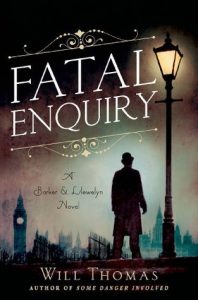 Last but not least there’s the resonance to the now in this story that is very much steeped in the ‘then’. Because while the case may be about the Mafia, what’s behind their advent into London is a debate about immigration and immigrants and just how easy or difficult it should be and just how much enforcement is necessary and which way and upon whom the economic impacts have and will fall.
Last but not least there’s the resonance to the now in this story that is very much steeped in the ‘then’. Because while the case may be about the Mafia, what’s behind their advent into London is a debate about immigration and immigrants and just how easy or difficult it should be and just how much enforcement is necessary and which way and upon whom the economic impacts have and will fall.
And doesn’t all of that sound bloody familiar?
I’m here for all of the above, but even if just one part of that appeals to you, the fully realized historical setting, the whodunnit, the network of ‘Irregulars’ that Barker and Llewelyn are developing, Llewelyn’s continued training, OR the way that the past links to the present, this series is utterly fan-damn-tastic every single step of the way.
The deeper I read into this series, the better it gets. Each book in the series has been tight, taut, thrilling and compelling, all at the same marvelous time. They’ve just been awesome so far, and I can’t recommend the whole thing highly enough – although I plan to keep trying. I also, of course, plan to keep reading, and suspect that it won’t be long before I pick up the next book in the series, Fatal Enquiry.
~~~~~~ GIVEAWAY ~~~~~~
 Because I’ve enjoyed this series so much so far, it was an obvious choice for one of this week’s Blogo-Birthday giveaways – especially as the latest book in the series, Death and Glory, is coming out later this month!
Because I’ve enjoyed this series so much so far, it was an obvious choice for one of this week’s Blogo-Birthday giveaways – especially as the latest book in the series, Death and Glory, is coming out later this month!
Drumroll please! On this third day of my Blogo-Birthday Celebration, today’s giveaway is the winner’s choice of ANY book in the Barker & Llewelyn series in any format, up to $25 (US) which should be enough to get even Death and Glory if you’re already caught up!
Good luck with today’s giveaway and remember that there’s more to come!


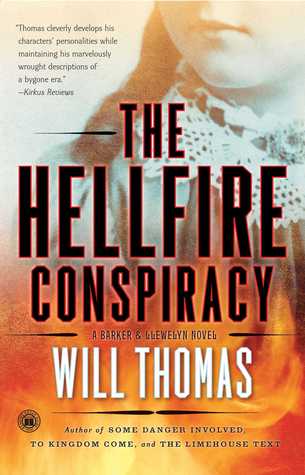 The Hellfire Conspiracy (Barker & Llewelyn, #4) by
The Hellfire Conspiracy (Barker & Llewelyn, #4) by 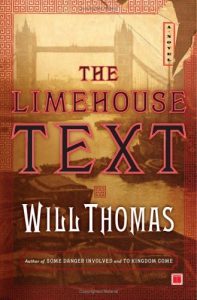 This fourth entry in the marvelously absorbing
This fourth entry in the marvelously absorbing 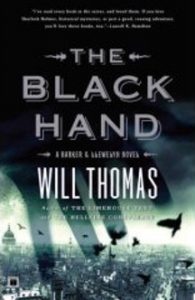 But it’s the characters of Cyrus Barker and Thomas Llewelyn themselves that keep the reader turning pages. Especially in a case like this one, where they go in knowing that the odds of a happy ending are very much against them, but determined to bring as much justice as can be had to all the victims of this atrocity; the living and the dead.
But it’s the characters of Cyrus Barker and Thomas Llewelyn themselves that keep the reader turning pages. Especially in a case like this one, where they go in knowing that the odds of a happy ending are very much against them, but determined to bring as much justice as can be had to all the victims of this atrocity; the living and the dead.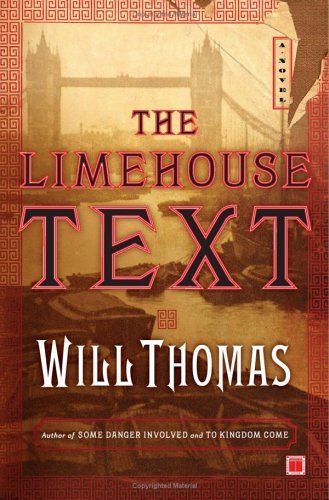 The Limehouse Text (Barker & Llewelyn, #3) by
The Limehouse Text (Barker & Llewelyn, #3) by 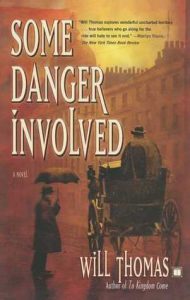 I was feeling in a bit of a murder-y mood this week – reading-wise at least. Which seems entirely fitting as we’re ‘killing’ 2023 this weekend and ringing in 2024.
I was feeling in a bit of a murder-y mood this week – reading-wise at least. Which seems entirely fitting as we’re ‘killing’ 2023 this weekend and ringing in 2024. 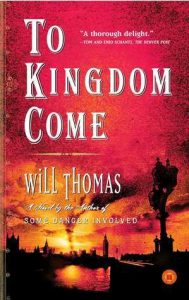 Escape Rating A+: One thing drove me utterly bananas during my reading of The Limehouse Text. I had the vague impression, not that I’d read this before, but that the Jeremy Brett Sherlock Holmes series had also tackled a story set in Limehouse – London’s Victorian version of Chinatown – but couldn’t track down precisely which story. I think it may have been
Escape Rating A+: One thing drove me utterly bananas during my reading of The Limehouse Text. I had the vague impression, not that I’d read this before, but that the Jeremy Brett Sherlock Holmes series had also tackled a story set in Limehouse – London’s Victorian version of Chinatown – but couldn’t track down precisely which story. I think it may have been 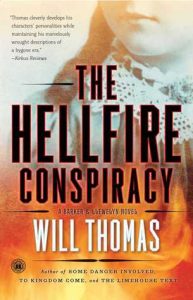 In the end, this is a clever, convoluted mystery, solved but not truly resolved by fascinating characters, steeped in a culture and a perspective that was not treated with any kind of respect in its time and about which stereotypes promoted during this period still linger. The reader is inexorably drawn in by the mystery and the setting, and left with both the satisfaction of at least some just desserts being served – as a mystery should – while still reeling from the marvelously presented microcosm of all the reasons why ‘colonialism’ is such a disgustingly dirty word in so many places around the globe to this very day.
In the end, this is a clever, convoluted mystery, solved but not truly resolved by fascinating characters, steeped in a culture and a perspective that was not treated with any kind of respect in its time and about which stereotypes promoted during this period still linger. The reader is inexorably drawn in by the mystery and the setting, and left with both the satisfaction of at least some just desserts being served – as a mystery should – while still reeling from the marvelously presented microcosm of all the reasons why ‘colonialism’ is such a disgustingly dirty word in so many places around the globe to this very day.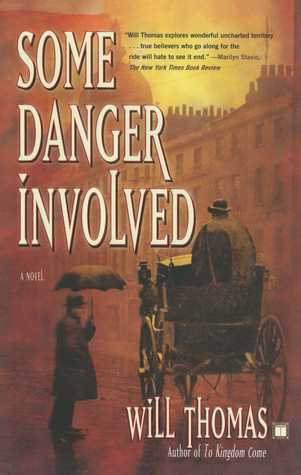 Some Danger Involved (Barker & Llewelyn, #1) by
Some Danger Involved (Barker & Llewelyn, #1) by 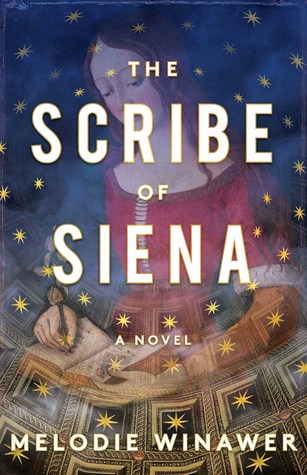 The Scribe of Siena by
The Scribe of Siena by